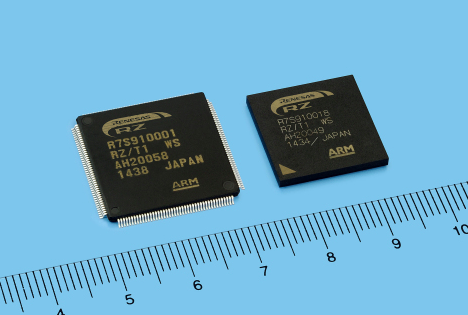Renesas Electronics Corporation, a premier supplier of advanced semiconductor solutions, today announced the RZ/T1 Group, a new factory automation solution with built-in industrial network functionality for use in many industrial applications such as AC servo drives, motion controllers, inverter control and general industrial equipment that require high speed, responsiveness, and excellent real-time performance.

Traditional solutions such as high-frequency microprocessors (MPUs) with cache memory are unsuited for real-time control because of the unpredictability characteristics of cache memory. And, while microcontrollers (MCUs) with on-chip flash memory are likewise marketed for real-time control, the increasing performance requirements are driving them to hit their performance ceiling.
In addition, deterministic, open standard networks such as EtherCAT®, EtherNet/IP™, and PROFINET are becoming mainstream in all types of industrial equipment. Supporting such standards typically requires the use of a separate ASIC with dedicated communication functionality, which leads to increased system cost and circuit board footprint.
The new RZ/T1 Group of devices are built around the ARM® Cortex®-R4F core operating at up to 600 megahertz (MHz) and are configured with two regions of tightly coupled memory (TCM, Note 1), which is linked directly to the CPU core, removing the need for cache memory. TCMs support critical routines, such as interrupt handling routines or real-time tasks, ensuring the highest level of responsiveness with no cache latency. The RZ/T1 also integrates the R-IN Engine industrial Ethernet communication accelerator. It provides the same multi-protocol features as the highly regarded Renesas R-IN Series, with support for multiple industrial Ethernet communication standards, including EtherCAT.
The RZ/T1 devices likewise retain many of the peripheral functions of the Renesas RX Family and SH Family, making it easier for system manufacturers to design scalable industrial control equipment systems leveraging multiple Renesas architectures.
Key Features of the RZ/T1 Solutions:
(1) Cortex-R4F core operating at up to 600 MHz and high-speed, large-capacity tightly coupled memory linked directly to the CPU core for high-speed processing and excellent responsiveness.
The RZ/T1 Group is built around the ARM Cortex-R4F core (rated at 1.66 DMIPS/MHz), which is designed for real-time processing, can operate at frequencies up to 600 MHz, and features a single/double precision FPU for efficient math operation. There are two TCM regions – 512 K utilized for code and operation and 32 K for data, both with effectively no-wait access from the CPU (Note 2). There is an additional 1 MB of RAM for use in the application to support better partitioning and efficiency. In addition, there is a vectored interrupt controller (VIC) in hardware that delivers high-performance, low-latency interrupt handling, further boosting real-time performance. These configuration enhancements make it possible to build systems with high-speed processing and excellent real-time responsiveness superior to those using conventional MCUs with on-chip flash memory or microprocessors employing cache memory.
(2) R-IN Engine industrial Ethernet communication accelerator
The RZ/T1 Group includes devices equipped with the industry-proven Renesas R-IN engine, which incorporates an Ethernet accelerator and a real-time OS accelerator (HW-RTOS). The R-IN engine includes a dedicated CPU core running at 150 MHz and implements the functions of a real-time OS in hardware, and handles the communication and peripherals for system-level efficiency. The R-IN engine is designed to support multiple industrial Ethernet communication standards, including EtherCAT, EtherNet/IP, and PROFINET. The recently launched R-IN Consortium is expected to provide a variety of solutions from Renesas and partner vendors that will reduce the time needed to develop industrial equipment.
(3) Peripheral functions retained from proven Renesas MCUs for scalability, and improved new peripheral functions and safety functions for industrial equipment
The SH Family and RX Family of Renesas MCUs have a proven track record in the field of industrial equipment, and the RZ/T1 inherits many of the peripheral functions, including well-established timers and communication functions. This simplifies the development by leveraging prior designs using other Renesas architectures, thus improving time to market. To meet the demanding reliability and safety requirements of industrial equipment, the on-chip memory, including tightly coupled memory, incorporates ECC functionality. Additional safety functions, including a register write protection function to prevent overwriting of key registers in case of program runaway, an input clock oscillation stop detection function, and an independent watchdog timer function all help to simplify safety certification.
(4) Addition of encoder interface support provides a single-chip AC servo solution
The RZ/T1 Group incorporates the real-time processing, low-latency memory, high-speed analog, and network connectivity that match the needs of many AC servo drive applications. In addition, Renesas plans to launch devices that will be an industry-first to feature an encoder interface that will support many of the motor feedback protocols such as EnDat 2.2 and sensor and actuator protocols such as BiSS® and SSI. These digital, bidirectional interfaces for encoders provide precise position values from incremental and absolute encoders. Typically implemented using FPGAs or ASICs, integrating this function on the RZ/T1 reduces the component count and cuts system costs.
With all the processing power and real-time architecture to manage tighter control loops, the network connectivity to support deterministic communication, and the capability of a high speed encoder interface all in a single chip, the RZ/T1 is truly an AC servo solution on a single chip.
With the addition of this new series of products to the RZ Family, Renesas now supplies solutions essential to the realization of the “smart society”. Renesas will continue to develop new products, ranging from the high-end to the low-end, in response to the emerging needs of the marketplace.
(Note 1) Tightly Coupled Memory (TCM):
The processor core accesses the high-speed on-chip memory directly through a dedicated memory interface, rather than via cache memory.
(Note 2) Of the tightly coupled memory, the BTCM supports access with no wait states. By using prefetching, the ATCM can fetch instructions with no wait states, provided no branching occurs.
Availability
The RZ/T1 Group includes ten new devices, and samples are scheduled to be available beginning January 2015. Mass production is scheduled to begin in October 2015. (Availability is subject to change without notice.)
Renesas
am.renesas.com
Leave a Reply